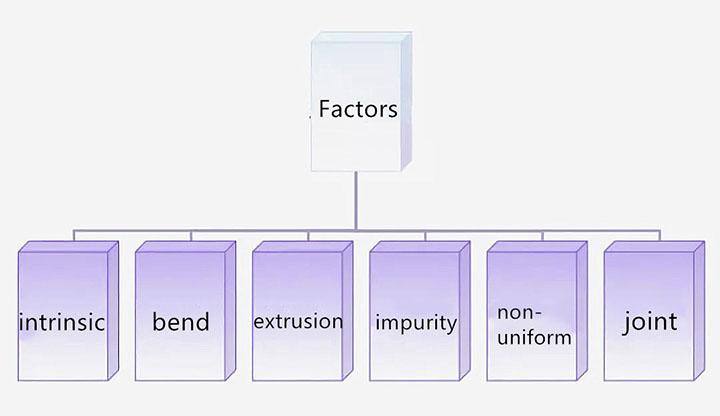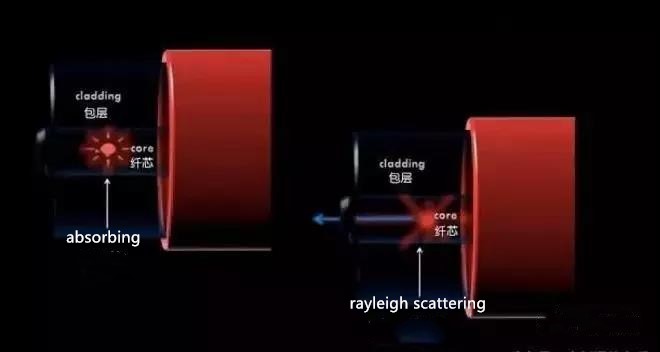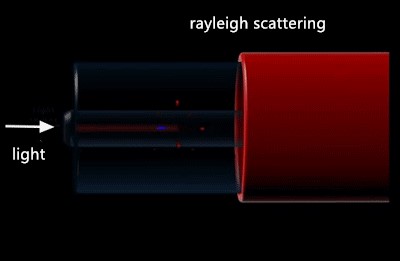
When light enters from one end of an optical fiber, it decreases in intensity from the other end. This means that as the optical signal travels through the optical fiber, the light energy is attenuated. That there's something in the fiber or for some reason that's blocking the light signal. This is the transmission loss of optical fiber. Only by reducing the loss of optical fiber can the optical signal be unobstructed.
Factors affecting of optical fiber attenuation

Intrinsic:The natural loss of optical fiber includes Rayleigh scattering, natural absorption, etc.
Bend:When the optical fiber is bent, some light in the optical fiber will be lost due to scattering
extrusion:A loss caused by the tiny bending of the fiber when it is squeezed
impurity:The impurities in the fiber absorb and scatter the light propagating in the fiber, causing the loss.
nonuniform:Loss caused by uneven refractive index of optical fiber materials
joint:Optical fiber splicing loss, such as: not coaxial (single-mode optical fiber coaxiality requirements less than 0.8 micron), end and axis is not vertical, end uneven, butt heart diameter mismatch and splicing quality。
Classification of optical fiber losses
The loss of optical fiber can be divided into the inherent loss of optical fiber and the additional loss caused by using conditions after the optical fiber is made. The details are as follows:
●The intrinsic loss includes scattering loss absorption loss and loss caused by imperfect structure of optical fiber
●Additional losses include bending loss, bending loss and connection loss
Among them, the additional loss is artificially caused in the laying process of optical fiber. In practical applications, it is inevitable to fuse the optical fiber one by one, optical fiber connection will produce loss, and optical fiber tiny bending, extrusion, tensile force will also cause loss, these are the loss caused by the use of optical fiber conditions. Below, we will read only the intrinsic losses of optical fibers。
In the intrinsic loss, the scattering loss and absorption loss are determined by the properties of optical fiber materials, and the natural loss is different under different working wavelengths. It is very important to find out the mechanism of loss and quantitatively analyze the loss caused by various factors。
A、 absorption loss
Materials used to make optical fibers absorb light energy. After absorbing the light energy, the particles in the fiber optic material produce vibration, heat, and dissipate the energy, thus producing absorption loss. We know that matter is made up of atoms, molecules, and atoms are made up of nuclei and electrons, which revolve around the nucleus in certain orbits。

The orbital closer to the nucleus has a lower energy level, and the orbital farther away from the nucleus has a higher energy level. The size of this difference between orbitals is called the energy level difference. When an electron transitions from a lower to a higher energy level, it absorbs the energy of the corresponding level difference.
In an optical fiber, when electrons in a certain energy level are exposed to a wavelength corresponding to the energy level difference, the electrons in the low-energy orbit will jump to the higher-energy orbit. This electron absorbs light energy, creating an absorption loss of light。
Silicon dioxide (SiO2), the basic material used to make optical fibres, absorbs light itself, one in the ultraviolet and the other in the infrared. At present, optical fiber communication only works in the wavelength region of 0.8 ~ 1.6 microns, so we only discuss the loss in this region。
The absorption peak produced by electron transition in quartz glass is about 0.1 ~ 0.2 μm wavelength in ultraviolet region. As the wavelength increases, the absorption decreases, but the effect is spread over a wide area until the wavelength is more than 1 μm. However, ultraviolet absorption has little effect on quartz fibers that work in the infrared region. For example, ultraviolet absorption can reach 1 dB/km at a wavelength of 0.6ms, drops to 0.2-0.3db/km at a wavelength of 0.8μm and to about 0.ldb/km at a wavelength of 1.2μm。
The infrared absorption loss of quartz fiber is caused by molecular vibration of infrared materials. There are several vibration absorption peaks over 2 μm。
Due to the influence of various doped elements in the fiber, it is impossible to have a low loss window in the band above 2 μm, and the theoretical limit loss of 1.85μm wavelength is 1 dB/km。
Another absorption of quartz optical fiber source is hydroxyl (OH ˉ) period of study, it was found that hydroxyl on working in the optical fiber band have three absorption peaks, respectively is 0.95 μm, 1.24 μm and 1.38 μm, 1.38 μm wavelength absorption loss is most serious, the impact on the optical fiber. At a wavelength of 1.38 μm, the absorption peak loss of hydroxide, which only accounted for 0.0001, was as high as 33dB/km。
Where did this hydroxide come from? There are many sources of hydroxyl. First, there are water and hydroxyl compounds in the materials used to make optical fiber. These hydroxyl compounds are not easy to be removed in the purification process of raw materials, and are still left in the optical fiber in the form of hydroxyl. Second, there is a small amount of water in the hydrogen and oxygen used to make fiber optics. Third, water is generated by chemical reaction in the manufacturing process of optical fiber. Fourth, the entry of outside air brings water vapor. However, manufacturing techniques have advanced to such a high level that the hydroxide content has been reduced to such a low level that the effect on the fiber is negligible。
B、scattering loss
In the dark, shine a flashlight into the air and you can see a beam of light. Thick columns of light from overnight aerial searchlights have also been seen。
So why do we see these beams of light? This is because there are many tiny particles of smoke and dust floating in the atmosphere. This phenomenon was first discovered by Rayleigh, so people named this scattering "Rayleigh scattering".

How does the scattering come about? The tiny particles, such as molecules, atoms and electrons that originally make up matter, vibrate at a certain natural frequency and can emit light with a wavelength corresponding to that frequency.
The vibrational frequency of a particle is determined by its size. The larger the particle, the lower the vibration frequency, and the longer the wavelength of the light emitted; The smaller the particle, the higher the vibration frequency and the shorter the wavelength of the light emitted. This vibration frequency is called the natural vibration frequency of the particle. But this vibration is not self-generated, it requires a certain amount of energy. Resonance occurs when a particle is exposed to light of a certain wavelength at the same frequency as the particle's natural vibration. The electrons in the particle start to vibrate at this vibration frequency, and the result is that the particle scatters light in all directions, and the energy of the incident light is absorbed and converted into the energy of the particle, which in turn re-emits the energy in the form of light energy. So to the observer from the outside, it looks as if the light hits the particles and flies off in all directions。
Rayleigh scattering is also found in optical fiber, and the resulting light loss is called Rayleigh scattering loss. In view of the current level of optical fiber manufacturing technology, it can be said that Rayleigh scattering loss is unavoidable. However, because the Rayleigh scattering loss is inversely proportional to the light wavelength of the fourth power, the influence of Rayleigh scattering loss can be greatly reduced when the fiber works in the long wavelength region。

C、Loss caused by imperfect structure of optical fiber
When there are bubbles, impurities, or uneven thickness in the fiber, especially the non-smooth core-cladding interface, when the fiber is transmitted to these places, some light will be scattered in all directions, causing loss. This loss can be overcome by improving the process of making optical fibers. Scattering makes the light shine in all directions, and some of the scattered light is reflected back along the direction opposite to the propagation of the optical fiber, which can be received at the incident end of the optical fiber.
The scattering of light results in some loss of light energy, which is undesirable. However, this phenomenon can also be exploited, because if we analyze the strength of the received beam at the sending end, we can check the breakpoints, defects and losses of the fiber.

In recent years, optical fiber communication has been widely used in many fields. To realize optical fiber communication, an important problem is to reduce the loss of optical fiber as much as possible. The so-called loss refers to the attenuation of optical fiber per unit length (dB/km). The loss of optical fiber directly affects the distance of transmission or the distance between relay stations. Therefore, it is of great practical significance to understand and reduce the loss of optical fiber for optical fiber communication。